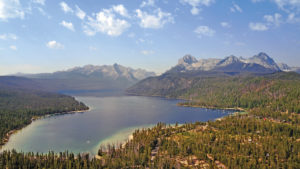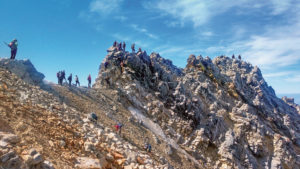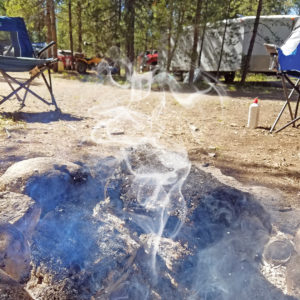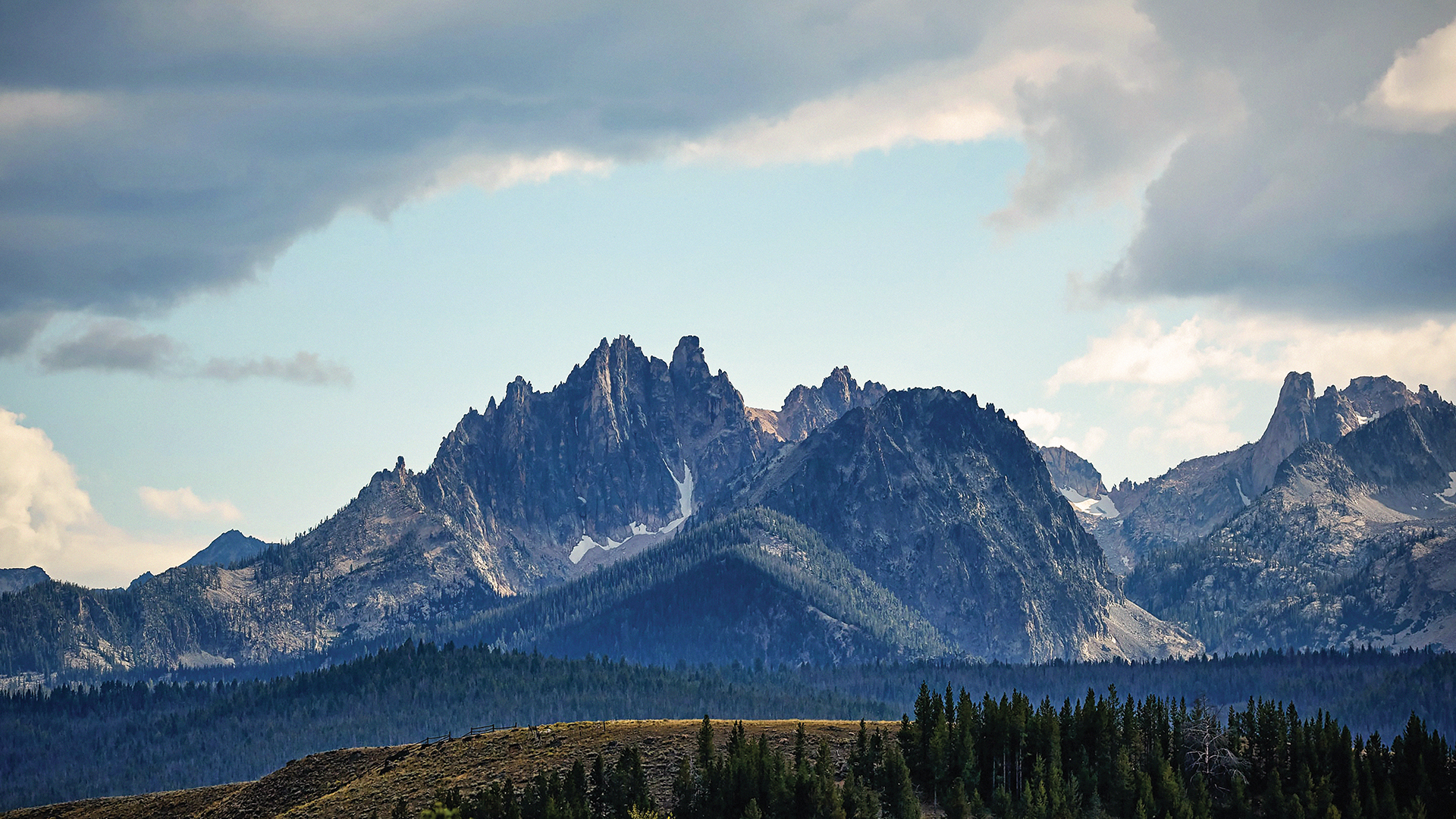It was obvious that things were different in Stanley, Idaho, and the Sawtooth National Recreation Area (SNRA) last summer. Campsites were full, hotels often had no vacancies, trailheads were packed, every spot that could fit a tent was occupied, and there’s no wonder why …
The COVID-19 pandemic defined and dictated our lives last year. Summer travel plans were canceled, quarantine fatigue set in, and then the Centers for Disease Control and Prevention announced that the likelihood of exposure to the virus was less out-of-doors, even without the use of masks, as long as social distancing was maintained. Outdoor recreation: hiking, backpacking, camping, biking and fishing are already social distancing at its finest. Still, workers in the outdoor industries and tourism expected a slow and uncertain season. Instead, what they got was close to chaos.
“We were in no way prepared [for the increase in visitors],” says Susan James, recreation programs manager for the Sawtooth NRA. “We were caught off guard. We thought people would be staying at home, not traveling.”

While the pandemic may have encouraged a larger-than-normal influx of people to the Sawtooth Mountains and Stanley Basin, the growth of Idaho, especially in the major cities, has dramatically increased. Idaho was the fastest growing state in the nation in 2019, according to the 2020 census data, and Boise was the fastest growing city in the nation in 2018.
“The growth of Idaho and interest in outdoor recreation has exploded,” says Gary Gadwa, a full-time Stanley resident who has, among other notable career achievements, served as commander of Sawtooth Search and Rescue for the last 40 years. “Add the pandemic on to that and people’s desire to get out of the city, and they naturally flock to the Sawtooths, an Idaho gem.”
Indeed, it is not difficult to understand what is alluring about this part of the world. The SNRA exists within the Sawtooth National Forest. Included in its 756,000 acres are the Sawtooth, Hemingway-Boulders and Cecil D. Andrus-White Cloud wilderness areas. The headwaters to four major Idaho river systems are anchored in these mountains, along with hundreds of glacial alpine lakes, over 700 miles of trail, elusive wildlife, which combine to create the truly spectacular and seemingly endless sceneries and vistas. There is still a sense of wildness and Western, untouched freedom in this place. Who can be blamed for wanting to experience it? Unfortunately, the development to support the many people that arrived did not exist.
“The amount of people camping in undeveloped areas was unprecedented,” remembers Jeff Clegg, the general manager of Redfish Lake Lodge, an historic establishment in central Idaho. The Lodge, which is in its ninth decade of operation, sits on the banks of the expansive Redfish Lake. It has acted as a gateway into the Sawtooth Wilderness. Trailheads and developed campgrounds flank the Lodge, and just a short boat ride across the lake delivers one into the heart of some of Idaho’s most iconic backcountry. Redfish has always been a natural starting point for vacationers, and last summer was no exception.
“Several areas near Redfish had people tucked in the trees, places I didn’t know were even a possibility,” recalls Clegg. “Concern for fire danger was high with so much use and so many novice campers. I do think the use is exceeding the developments and the Forest Service’s ability to manage. I don’t have the answers, and I know the Forest Service is doing all they can with the personnel they have, but it is a complex and large challenge.”
The seasonal staff within the Forest Service recreation program varies from year to year depending on funds, but it usually includes four or five trail workers, two to four people on a recreational crew and four wilderness rangers. When asked if she would like to have a larger staff, James laughs at the ridiculousness of the question. “Of course I would love that!”
The hurdle to hiring more staff, in the Forest Service in general, is not having a consistent budget that can be reliable. There is a lot of risk in trying to plan ahead. The budget changes every year based on the amount of money that was used in the previous year. Another source of monetary assistance come from grants that can be applied to specific projects.

The crowds on top of Borah Peak in the Salmon-Challis National Forest
“Approximately 30 percent of our annual recreation operations comes from outside sources,” James explains. “In a perfect world, these funds would be supplemental to a sufficient and stable budget that would cover our baseline operations including staff and maintenance.”
To supplement manpower for maintenance, special projects and public education, the Forest Service partners with a list of local and interested groups and volunteers. They’re invaluable and necessary just as much as people who make maintaining these mountain resources their jobs.
Lara Antonello is the bear education outreach coordinator, or self-proclaimed Bear Lady. She is the first and only person to hold this job title for the SNRA. Her job was created as part of the new Bear Food Storage Order. The order requires food, garbage or any bear-attracting smelly things to be stored in a bear-resistant container, closed car or, if you’re in the backcountry, 10 feet off the ground away from campsites. The purpose of the new order is to reduce interactions between bears and humans. Properly storing bear attractants protects these creatures. As the adage goes, “A fed bear is a dead bear.” A bear that finds human food in tents or in open cars is likely to continue to enter tents and cars. This behavior puts people in danger, and as a result, these bears are often euthanized.
Miraculously, no bears were euthanized last summer in the SNRA, although there were many bear/human interactions. This success was part management and part luck, since there was a lot of foraging available, so human food was not as tempting. Lara feels it was also a result of tirelessly educating campers.
“The way I spoke to people was ‘Did you know…’ instead of reprimanding them,” explains Antonello. “Who am I to tell people that they can’t be here. Most people want to follow the rules and be safe and not get tickets.”

An unattended campfire can lead to devastating results.
Antonello felt her messaging was positively received by most people, who had no idea that their actions could negatively affect the wildlife. On average, they wanted to know more, and this encouraged her.
“As hard as it is to see increased use,” Antonello said, “I was so happy to see people of all social and economic backgrounds enjoying the outdoors. In the long term, more good than bad can come from that if we educate. Education is going to change everything.”
Education about how to exist in wilderness as polite guests includes cleaning up after ourselves and not setting the whole place on fire. James recalls a day she spent out with one of the wilderness rangers last summer. “He told me he had buried more human poop and cleaned up more used toilet paper than he ever had before. I watched him give the ‘poop’ talk maybe a hundred times that one day I was with him.”
If a wilderness ranger isn’t burying other people’s poop, they’re probably putting out fires. There were 342 unattended fires last year, according to James. There are many places in the Sawtooths where fires aren’t even allowed, let alone lit on bare ground without a fire pan or blanket. Although a camping trip may not feel complete without a fire, the best that can be said is; get over it. Thirty-four percent of wildfires that have happened in the SNRA in the last 10 years were due to human-made campfires.
Access to these rules is available, if they are sought out. Making conscientious recreating mainstream is one of those challenges that the Forest Service is facing, as is safety in our national forests and public lands. Walking into the backcountry with little or no experience can not only be damaging to the area, but it can also be very dangerous for the people themselves.
“Some people are ill-prepared or totally unprepared,” says Gary Gadwa, who spends more and more of his time, and the time of the Sawtooth Search and Rescue volunteers, responding to minor injuries or easily lost hikers. “People have unrealistic confidence in their physical abilities and find they have no trail-finding or navigational skills.”
Gadwa feels the increase in cellphone coverage in the mountains has in some ways become a burden and thinks people rely too heavily on them and other GPS and messaging tools. According to Gadwa, about one-third of the calls that the Sawtooth SAR were dispatched to were not necessary and used up their limited time, energy and resources.
“Some people come so unprepared, they really shouldn’t even be leaving the highway,” laments Gadwa.
Still, people will continue to visit and recreate armed with
only granola bars, plastic ponchos and their cellphones. And the services that will help them when they get into trouble are made mostly of volunteers.
Hannah Baybutt, a volunteer emergency response technician (EMT) for Stanley Ambulance, would like to see something
more permanent.
“It’s hard for volunteers to work jobs that keep them living in Stanley and still be able to respond to calls,” says Babyutt. “It is possible for a call to go unresponded.”
Baybutt is working toward implementing a seasonal full-time staff for the ambulance that can create consistency and stability for the busiest time of the year in Stanley. Most people the ambulance responds to in the summertime are visitors, and Baybutt thinks there should be a way for them to pay for the services they receive while visiting.
“I want visitors, and also people who buy houses and property in Stanley, to commit to the community,” says Baybutt. “I want people who love this place to invest in it so it can change for the better.”


